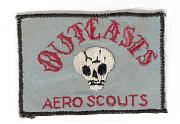Challenge: What makes us think the OODA Loop concept—if we believe it works to explain single entity versus single entity conflict—can apply to understanding aggregates of entities fighting aggregate of entities?
Response: This is perhaps the most important question regarding the applicability of the OODA Loop. Certainly a number of thread posters have expressed doubt about this. So this deserves a lengthier response.
We’ve already talked about the wrestler analogy—this is perhaps most akin to air combat maneuvering. A single decisionmaker pitted against another single decisionmaker. I need to elaborate a bit here, because Wilf and others have brought up chess players as an analogy—where does application of the OODA Loop work for chess?
I’d ague it doesn’t. For the simple reason that chess play is regulated by turns. Each side will ALWAYS get to react to the move of the opponent’s last move. There are no possibilities to get in two moves instead of just one. I get a move, you get a move. So the pace/tempo of the game is regulated by the rules.
Now, it’s been brought up that, given timed moves, a player that exhibits superior OODA capabilities should be able to apply this to win. True, but irrelevant to OODA loop implications that I’ll get into in a bit. Sure, expert players can “orient” and “decide” better and faster. But the issue is ultimately about quality of the moves. The players (or the tournament) decide ahead of time how long the chess clock limits are. Those limits never change. And the question comes down to quality of decisions made in that never-changing time limit. I just don’t think this equates to war very well.
Now, for those familiar with Ed Glabus and Aegis Corporation’s old InfoChess game, elements of the OODA are introduced. It’s a double-blind game with the ability to buy Information Operations capabilities. It’s very possible in that game that the opponent won’t get to execute his move when it’s his turn, particularly if he’s the victim of a successful Electronic Attack (EA) mounted by his opponent. But this is relatively rare—most of the issues in InfoChess involve quality of the moves. Players are bent on deception and operations security versus intelligence and counterintelligence most commonly. Even in InfoChess, there is still that pacing function. Sure, you have a better shot at getting into two moves to the opponent’s one given a successful EA operation, but this is an example of lengthening the enemy’s OODA Loop and not tightening your own and dealing with the consequences of that.
Maneuverists do talk a good bit about chess masters. But mostly it’s about expertise—and how that expertise means that true experts take much less time to orient and decide. That’s why MW is so difficult. You need experts—and you need to develop them. The maneuverists argue that the results are worth the cost. If you disagree with that—that the U.S. military cannot grow that many experts—then the argument is pretty much over. You and the “German School” maneuverists have different assumptions and value systems; you aren’t going to be able to agree on anything. However, you may have something in common with the Soviet school, more on that later.
Anyway, back to the issue at hand--
An understanding of OODA Loop theory, developed from F-86 versus MiG-15 dogfights, explains much regarding why some ACM matchups in Vietnam worked the way they did. And Boyd certainly applied this understanding to E-M theory, which revolutionized how we design and evaluate fighter aircraft. Okay. If somebody wants to attack that idea, I’d welcome it. But let’s assume for a minute that this is true. What makes Boyd make the leap into other realms of war, particularly those involving larger formations?
Most of the maneuverists will point to how basketball players play basketball. Or soccer players play soccer. Or hockey players play hockey. Or so on. Sure, offensive/scoring ability counts, defensive skills count, but being able to manipulate the tempo of the game is something each team strives to achieve. In “blowout” games, usually it’s pretty clear the winning team completely dominated the opposition, being able to pre-empt, dislocate, and disorient the other team. Those maneuverists, such as John Schmitt, will explain this effect in OODA Loop terms. IN such instances, Schmitt points to the lateral communication between the team members—the coach is unable to influence much of the play from the sidelines compared to other games such as American football or baseball. The game is in the hands of the players. These kinds of games show recon-pull in action. When gaps or holes in the defense are found, players naturally gravitate to it/exploit it without waiting for someone (like the coach or the team captain) to tell them.
The question is whether you can believe that this analogy will hold for larger aggregates of units in violent competitions where there are higher levels of uncertainty.
Both the German and Soviet school advocates will concede that this holds—the OODA Loop is applicable in such instances. The difference between them is with regard to where the experts are. For example, to use the basketball analogy—do I have a team that’s played several seasons together? If I do, the players are able to decentralize command and control and implement “recon pull” to immediately exploit discovered gaps. The commander doesn’t have to explicitly direct such exploitation. Soviet school pretty much assumes you have a “pick up”/”back lot” basketball team—team members don’t know each other, implicit communication is at a minimum, and so on. So there’s much more emphasis put on preparation—speed and focus is achieved through better planning BEFORE the operation, as opposed to German school which depends on speed and focus occurring DURING the operation.
So the basic question that differentiates the two schools boils down to this: do you have people that can make independent decisions? If you believe that can’t happen at lower levels—such independence is reserved for senior levels—then you are a Soviet school advocate. If you think you can grow that kind of effective independence at low levels, then you’ll lean to the German school.
Commercial wargaming provide some potential insights. My favorite system to explore this is the MMP/The Gamers Tactical Combat System. In this game, players have to write operations orders with sketches in order for units to conduct operations. You must designate objectives, provide control measures (where to move, what unit boundaries are, etc), and so on. The interesting thing about the game system is that units don’t obey orders as soon as they get them. A number of variables come into play. The first (and some say the most important) variable is how quickly the inherent command and control system accepts new instructions. There are other variables, such as whether the formation is currently in contact or is out of contact (better). And so on. Every turn that an new order is levied against a formation, a die is rolled. The player cannot possibly be sure WHEN a formation will accept and then execute a given order. Playing the numerous games in this series leads players to prefer the sides that have the lowest implementation values. In other words, players want to play the side that accepts and executes orders faster. While they can’t predict when orders will be accepted and executed, there is the possibility that one side will accept and execute orders faster than the other side. While there are exceptions on a case by case basis (i.e., occasionally luck will cause the slower unit to execute orders faster than the faster unit), overall the faster implementing side will get the majority of “jumps” on the opponent in conducting operations. This is a huge insight and leads to a depth of understanding regarding how the OODA Loop works in practice.
But this won’t be convincing to a number of people who will want to judge how well this works given historical examples. Maneuverists will point to a number of well-worn examples where shorter OODA cycles (for the German School, this typically involves recon-pull examples) contribute to situations where the enemy’s actions are rendered “too little, too late.”






 and horrified when they were subsequently named to command that theater
and horrified when they were subsequently named to command that theater





 "A Sherman can give you a very nice... edge."- Oddball,
"A Sherman can give you a very nice... edge."- Oddball, 
Bookmarks